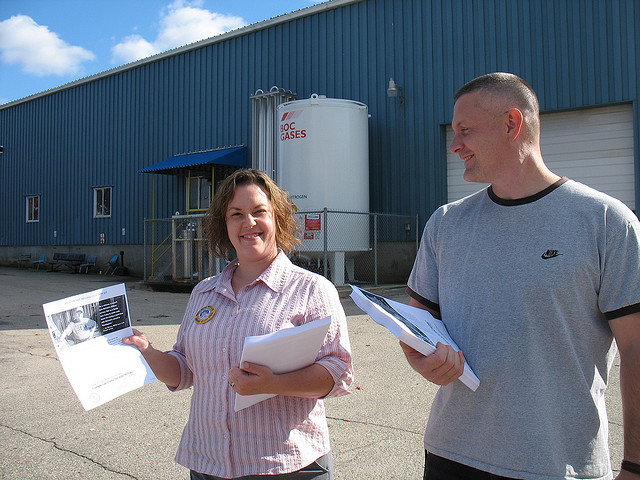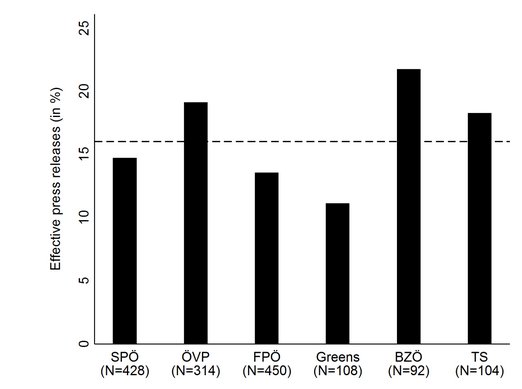The media’s gatekeeping function means that party press coverage often reproduces and reinforces existing power structures
In election campaigns, parties and candidates want to get their message across to the public, and the central means of doing so is by generating media coverage. Yet, the media does not slavishly pay attention to each party’s campaign messages. Which actors are most likely to hit the media? And which campaign messages are most likely to make the news? Thomas M. Meyer, Martin Haselmayer and Markus Wagner present research which shows that parties are in general rather successful in getting their messages to the media. However, the media’s gatekeeping function also reproduces existing distributions of power and attention: party messages are most likely to be covered if messages are spread by powerful politicians and if they fit with the current media issue agenda.

Credit: Bernard Pollack, CC BY 2.0
During a campaign, little is more important to political parties and candidates than getting their message across to voters. Before an election, potential voters are bombarded with advertising, campaign leaflets and media coverage, all meant to mobilise, inform or persuade. Large amounts of financial and personal resources are invested in these activities: in the UK, the parties spent over 30 million pounds in the 2010 general election. Of course, this sum pales in comparison to the US, where over 2 billion US dollars were raised by the two 2012 presidential campaigns. In the Austrian general election campaign (the example we will discuss in this post), parties spent about €47.7 million (£33.4 million), or about €7.50 (£5.25) per registered voter. But are these campaign efforts actually effective?
One way of answering this question is to look at whether parties and candidates get the media coverage they aim for. During a campaign such coverage is essential if parties want to make their candidates and policies known, even if parties also do a lot to reach voters more directly (e.g. in advertisements or TV debates).
To get into the media, parties routinely send out press releases, in the hope that these will be noticed by journalists and editors and in some way incorporated into news stories. One key advantage of press releases is that they are relatively cheap to produce, so they are a quick and easy way to try to get media attention. If the press release is quoted – or perhaps even inspires a news story – then the party will have managed to get its message across to readers. Journalistic coverage may be even better than advertising or leaflets since voters may see news stories as more credible.
Our study of the 2013 Austrian general election compares 1,500 press releases and 6,000 media reports from six newspapers using cheating detection software (a method pioneered by Justin Grimmer). We used this software to pre-select pairs of press releases and news stories that appear to be similar. We then examined each of these pairs one by one and distinguished effective press releases (i.e. those that appear in the media) from ineffective ones (i.e. those that do not).
How effective are party press releases? Journalists and editors get about 40 press releases from parties a day, and on average 6 of these are quoted or referred to in at least one news story. This is an astonishingly high success rate of about 16 per cent. This 1 in 6 chance of getting coverage is especially good considering that press releases are so easy and cheap to produce compared to campaign posters or newspapers advertisements. Journalists and editors also get press releases from many other sources such as interest groups or firms, so parties have to compete with other actors for attention. So, in general, parties are surprisingly effective in getting into the media.
Party press releases are particularly effective if they focus on the ‘right’ issues. Specifically, journalists and editors tend to pick those press releases that deal with issues already prominent in the media. The more newspapers are covering an issue already, the more attention they will pay to a press release on that topic. This is probably because newspapers like to present various sides of a story – ideally, there should be discussion and even conflict between different parties. It is also easier for journalists to cover a continuing news story than to introduce new topics to readers.
Figure 1: Share of press releases in media reports depending on media issue attention
The differences in success rates between issue areas is large. In Figure 1, we show the relationship between media issue coverage and the share of effective press releases on each topic. Parties that want to get into the media will clearly have more success if they focus on issues currently being discussed in the news. For instance, about 1 in 4 press releases on corruption gets into the media. In contrast, editors and journalists barely seem to take note of press releases on pensions, even though this is one of the most important issues to voters: only about 3 per cent of these press releases on this topic appear in the media. (For more details on this analysis, see our paper.)
Figure 2: Share of press releases in media reports, by party
At least in Austria, it is not the case that the media in general favour some parties over others: success in getting coverage is quite evenly spread across parties. Figure 2 shows the average effectiveness of press releases for each party, and the parties in government (SPÖ & ÖVP) and larger parties (SPÖ, SPÖ and FPÖ) are about as effective in making the news as opposition parties (FPÖ, Greens, BZÖ, TS) and smaller parties (in particular the BZÖ) – although larger parties do, of course, send a lot more press releases than smaller ones.
Figure 3: Share of press releases in media reports, by role
Yet, there are important differences within parties: the media are more likely to pick up press releases sent by politicians who hold high public or party office. Figure 3 visualises the share of effective press releases for different groups of party actors. Press releases from cabinet members of the national or regional government are most likely to be effective, and party leaders are equally successful. Party chairpersons (who organise the campaigns) are also more likely to make the news than ordinary MPs or other party actors.
Press releases are important tools for parties, and they are surprisingly effective ways of getting into the news. However, press releases are not made equal: it helps if press releases are sent out by high-ranking politicians and if they address issues that are already prominent in the media. This shows how difficult it can be for some politicians and topics to reach the public: backbench MPs and marginal issues are rarely successful in gaining the attention of newspapers. In this way, the media, through its gatekeeping function, reproduces existing distributions of power and attention.
—
This article gives the views of the author, and not the position of Democratic Audit UK, nor of the London School of Economics. Please read our comments policy before commenting.
—
 Thomas M. Meyer is Assistant Professor at the Department of Government, University of Vienna. His research focuses on elections, parties and party competition, and coalition governments.
Thomas M. Meyer is Assistant Professor at the Department of Government, University of Vienna. His research focuses on elections, parties and party competition, and coalition governments.
 Martin Haselmayer is a pre-doctoral researcher at the Austrian National Election Survey (AUTNES), Department of Communication, University of Vienna. His research focuses on political communication, party competition and text analysis.
Martin Haselmayer is a pre-doctoral researcher at the Austrian National Election Survey (AUTNES), Department of Communication, University of Vienna. His research focuses on political communication, party competition and text analysis.
 Markus Wagner is Assistant Professor at the Department of Methods in the Social Sciences, University of Vienna. His research focuses on the role of issues and ideology in elections and party competition.
Markus Wagner is Assistant Professor at the Department of Methods in the Social Sciences, University of Vienna. His research focuses on the role of issues and ideology in elections and party competition.








 Democratic Audit's core funding is provided by the Joseph Rowntree Charitable Trust. Additional funding is provided by the London School of Economics.
Democratic Audit's core funding is provided by the Joseph Rowntree Charitable Trust. Additional funding is provided by the London School of Economics.
[…] Consequences. How would you prefer to vote? The Electoral Reform Society (ERS) has just published its report on what it calls the most unfair election in the UK, ever. It has suggested that using differing electoral systems the votes would have been as follows: Their full analysis is here. I would probably opt for larger constituency STV (single transferable vote) as the ERS does. What seems impossible to justify any longer is first past the post. That worked in a two party system. The media’s gatekeeping function means that party press coverage often reproduces and reinforces e…. […]
1 von 6 Partei-Presseaussendungen im Wahlkampf findet Weg in Medienberichterstattung https://t.co/FhFMqmsff1
The media’s gatekeeping function means party press coverage often reproduces & reinforces existing power structures https://t.co/uVzT20MrxG
Media’s gatekeeping function means that party press coverage reproduces existing power structures https://t.co/kUK8Ax8eeA @democraticaudit
The media’s gatekeeping function means party press coverage often reproduces & reinforces existing power structures https://t.co/acCPyMlAfO
The media’s gatekeeping function means that party press coverage often reproduces and reinforces existing power st… https://t.co/ZqeBx5IIWB
The media’s gatekeeping function means that party press coverage often reproduces and reinforces existing powe… https://t.co/IvQj36L03v
The media’s gatekeeping function means that party press coverage often reproduces and… https://t.co/sV9NRtOXYX https://t.co/cIhW1epCms